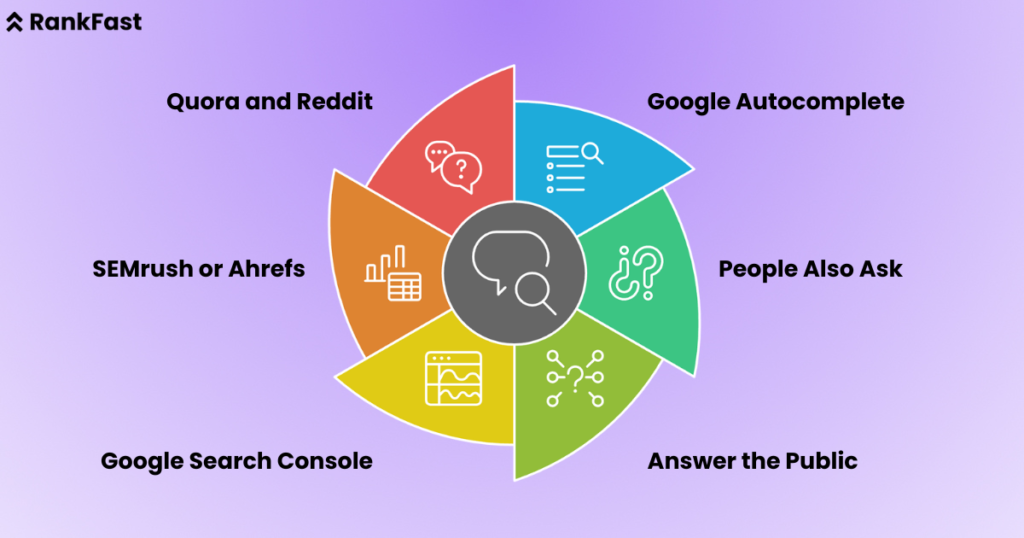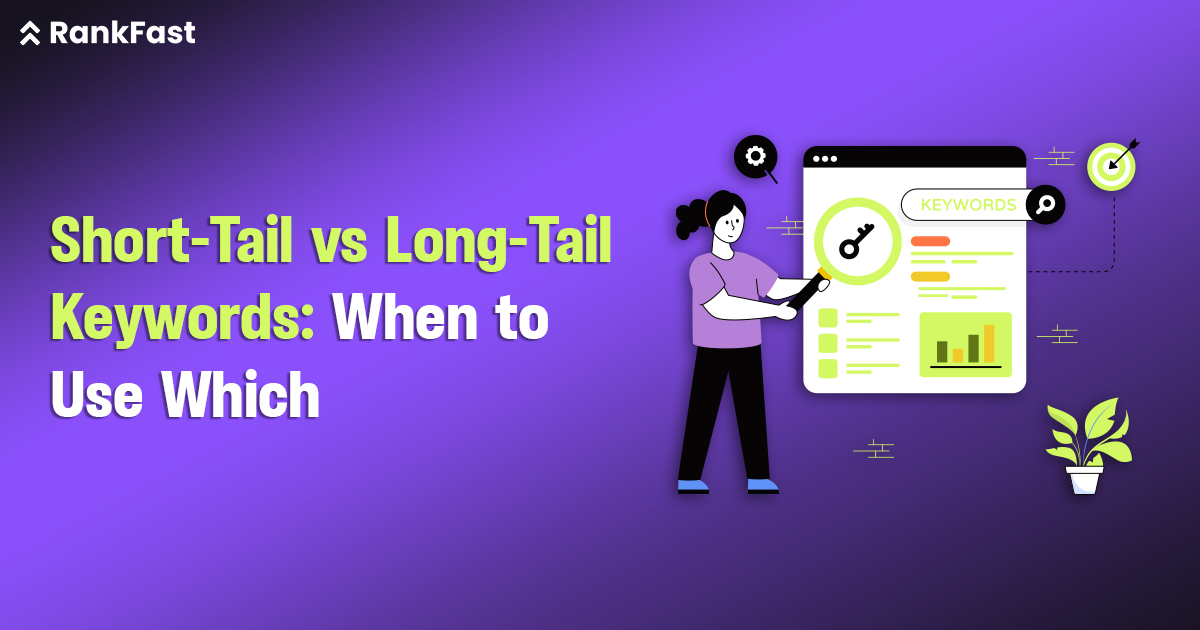Why do so many websites fail to rank, even after spending weeks writing content?
One common reason is a wrong keyword strategy.
Most beginners focus on broad, popular search terms. They think more volume means more traffic. But the truth is, they get buried under big brands. On the flip side, others only chase long-tail keywords and end up attracting barely any clicks. The balance is missing.
Here’s a surprising fact: 91.8% of all search queries are long-tail keywords, but they make up just 3.3% of the total search volume. That means most people search using longer, specific phrases, but very few of those bring in big traffic numbers.
This blog explains the difference between short-tail and long-tail keywords, how to use them, when to pick which one, and how to mix both smartly in your SEO strategy.
Let’s break it down.
What Are Short-Tail Keywords?
Short-tail keywords are search phrases made up of one to two words. They are also called “head keywords.” These are very broad and have a high search volume.
Examples of short-tail keywords:
- Shoes
- SEO
- Digital marketing
- Gym
- Laptops
These keywords get thousands to millions of searches per month. But here’s the problem: they are extremely competitive. Almost every brand in that niche is trying to rank for them.
Short-tail keywords don’t tell much about the user’s intent. If someone types “shoes,” are they looking to buy shoes, learn about shoes, or compare brands? We don’t know.
Characteristics:
- Very high competition
- High search volume
- Low conversion rate
- Very broad
- Expensive for paid ads
If you are a new website, targeting these keywords directly is like trying to shout in a stadium full of screaming people.
What Are Long-Tail Keywords?
Long-tail keywords are longer and more specific phrases. They usually have 3 or more words and show clear user intent.
Examples of long-tail keywords:
- Best shoes for flat feet women
- How to do SEO for YouTube videos
- Digital marketing strategies for small businesses
- Best gym near Andheri East
- Lightweight laptops under ₹50000
These keywords get fewer searches per month. But they have better conversion rates because the searcher knows exactly what they want.
Characteristics:
- Low competition
- Low search volume (individually)
- High conversion rate
- More specific
- Cheaper in paid ads
If your content answers a long-tail keyword properly, it becomes easier to rank, even if your domain is new.
Long-tail keywords are less glamorous, but they bring quality traffic. They also support your overall SEO by targeting niche audiences.
Key Differences Between Short-Tail and Long-Tail Keywords
Now that we understand both, let’s compare short-tail and long-tail keywords across different factors. But before that, here’s what you should know: Short-tail is great for awareness. Long-tail is better for conversions.
Comparison Table:
| Feature | Short-Tail Keywords | Long-Tail Keywords |
| Number of Words | 1–2 words | 3+ words |
| Search Volume | Very high | Moderate to low |
| Competition | Extremely high | Low to medium |
| Conversion Rate | Low | High |
| CPC (Cost-per-click) | Expensive | More affordable |
| User Intent | Unclear | Very specific |
Supporting Notes:
- Intent clarity matters more than volume. A clear query often leads to better user actions, like clicks or purchases.
- If you’re launching a product, short-tail might help in branding. If you want leads or sales, long-tail performs better.
- Google rewards content that matches intent, not just keywords.
When to Use Short-Tail Keywords
Short-tail keywords are not always bad. They have a place in SEO strategy, especially for established websites or big companies.
Use them when:
- You’re building brand awareness.
- Your domain authority is high.
- You want to drive massive traffic (even if it’s not targeted).
- You’re creating broad topic cluster pages or category pages.
- You’re running paid campaigns with a high budget.
Examples of where to use:
- Homepage content: “SEO services,” “digital marketing”
- Pillar content: “Marketing guide,” “Fitness tips”
- Meta titles: for ranking in categories
- YouTube tags: for increasing reach
Tips:
- Use short-tail keywords as base keywords. Then expand them in your content with long-tail variations.
- Always combine them with intent-based keywords to avoid bounce rate issues.
- Make sure your content is deeper than your competitors, or you’ll never outrank them.
Short-tail is tough, but if used right, it can give you a wide net of exposure.
When to Use Long-Tail Keywords
For small businesses, long-tail keywords are pure gold.
They bring people who are ready to take action, book, buy, contact or sign up.
Use them when:
- You have a new website or blog
- You want to rank faster
- You need targeted traffic
- You’re doing voice search optimization
- You’re making local SEO strategies
Example scenarios:
- A home baker in Pune wants to rank. Use “custom birthday cakes in Pune.”
- A personal trainer wants more leads. Use “best personal trainer for weight loss in Delhi.”
- An app developer wants projects. Use “freelance app developer for Android in Mumbai.”
Tips:
- Add location names, specific use cases, and adjectives.
- Use long-tail keywords in headings, subheadings, and FAQs.
- Write blog posts answering real user queries using long-tail phrases.
Long-tail doesn’t mean low results. It means focused effort and better output.
How to Find the Right Keywords for Your Strategy
Finding the right keyword is like choosing the right road. Wrong turn? You lose time and energy.
Techniques to use:

- Google Autocomplete
Type a phrase and see what Google suggests. Those are real user queries. - People Also Ask
Use this section to build FAQs or long-tail blog topics. - Answer the Public
This tool shows how people ask questions around a keyword. - Google Search Console
Check which queries already bring traffic. Expand them. - SEMrush or Ahrefs
Paid tools, but worth it. Use for keyword difficulty, CPC, and trend data. - Quora and Reddit
Look for pain points in your niche. Turn them into keywords. - Customer Chats/Emails
Use the same phrases your customers use while asking you questions.
Bonus Tip:
Mix both types of keywords. Use short-tail in your pillar pages and long-tail in blog posts or product descriptions.
Short-Tail vs. Long-Tail: Which Is Better for SEO?
There’s no one answer. It depends on your goal and stage of business.
Ask these questions:
- Are you trying to build brand visibility?
- Do you want fast traffic or long-term stability?
- Is your audience broad or niche?
- What is your ad budget?
Use short-tail if:
- You have authority and backlinks
- You can handle paid ads and content marketing
- You want to own a category or industry term
Use long-tail if:
- You want better ROI
- You’re targeting specific customer problems
- You’re building organic traffic slowly and steadily
Smart SEO strategy combines both. Think of short-tail as your tree trunk and long-tail as your branches. You need both for a strong SEO tree.
Conclusion
Choosing between short-tail and long-tail keywords is not just a matter of search volume. It’s about strategy. Short-tail keywords bring reach, but long-tail keywords bring results.
Don’t just chase numbers. Chase intent.
For new websites, start with long-tail. Build your authority. Once you grow, use short-tail to expand. Keep reviewing your keyword mix every month.
We are Rankfast, and we help businesses like yours rank faster with smart keyword strategies, content plans, and technical SEO. Need help? Get in touch today.
Let’s rank fast. Together.
FAQs
1. What is an example of a short-tail keyword?
“Shoes” is a short-tail keyword. It has a huge volume but is hard to rank for due to broad intent and high competition.
2. Are long-tail keywords better for new websites?
Yes. Long-tail keywords have low competition and high intent. They help new websites rank faster.
3. Can I use both short-tail and long-tail in the same content?
Absolutely. That’s a smart strategy. Use the short-tail in the title or H1, and the long-tail throughout the body.
4. Do long-tail keywords have enough traffic?
Individually, no. But together, they drive most search traffic. Over 90% of all searches are long-tail.
5. How many keywords should I target per blog?
Ideally, 1 primary keyword and 3–5 secondary long-tail variations. But focus on user intent, not just count.
6. How to find long-tail keywords for free?
Use Google autocomplete, “People Also Ask,” Reddit, Quora, or Google Search Console. Listen to how your customers speak.

Leave a Reply